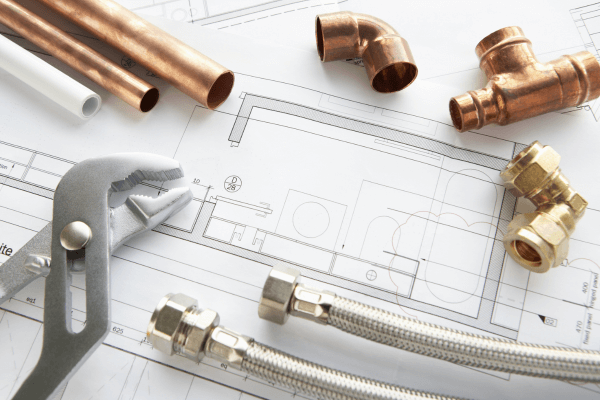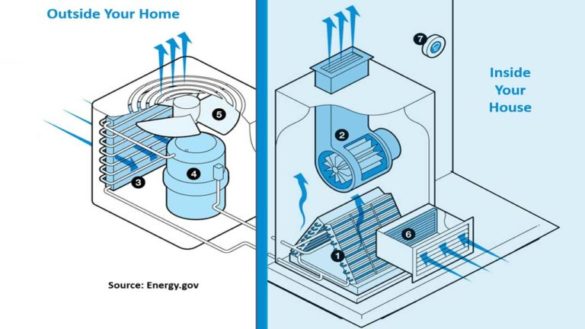Just about everyone has their unique theory with regards to Understanding Your Home's Plumbing Anatomy.

Understanding how your home's plumbing system works is crucial for every single homeowner. From delivering clean water for drinking, food preparation, and showering to securely eliminating wastewater, a well-kept plumbing system is crucial for your family members's wellness and convenience. In this detailed guide, we'll explore the complex network that comprises your home's plumbing and offer tips on upkeep, upgrades, and managing typical concerns.
Intro
Your home's plumbing system is more than simply a network of pipelines; it's a complex system that guarantees you have accessibility to clean water and efficient wastewater elimination. Understanding its elements and exactly how they collaborate can aid you stop expensive repairs and make sure everything runs efficiently.
Basic Components of a Plumbing System
Pipelines and Tubing
At the heart of your pipes system are the pipes and tubes that carry water throughout your home. These can be constructed from different products such as copper, PVC, or PEX, each with its advantages in regards to sturdiness and cost-effectiveness.
Components: Sinks, Toilets, Showers, etc.
Components like sinks, toilets, showers, and bath tubs are where water is utilized in your home. Recognizing how these components link to the plumbing system assists in detecting problems and intending upgrades.
Valves and Shut-off Points
Valves regulate the flow of water in your plumbing system. Shut-off shutoffs are crucial throughout emergencies or when you require to make repairs, enabling you to separate parts of the system without disrupting water flow to the whole residence.
Supply Of Water System
Key Water Line
The primary water line attaches your home to the community water or a personal well. It's where water enters your home and is dispersed to various components.
Water Meter and Stress Regulator
The water meter actions your water usage, while a stress regulator makes certain that water streams at a secure pressure throughout your home's plumbing system, stopping damage to pipelines and components.
Cold Water vs. Hot Water Lines
Comprehending the difference between cold water lines, which supply water straight from the main, and hot water lines, which lug heated water from the water heater, aids in troubleshooting and preparing for upgrades.
Drain System
Drain Pipes Pipes and Traps
Drain pipes bring wastewater far from sinks, showers, and toilets to the sewer or septic tank. Traps stop sewage system gases from entering your home and also trap debris that might create clogs.
Ventilation Pipes
Air flow pipelines permit air right into the water drainage system, preventing suction that could slow down drain and trigger catches to empty. Appropriate ventilation is necessary for keeping the honesty of your plumbing system.
Importance of Correct Water Drainage
Ensuring proper drainage prevents backups and water damage. Consistently cleaning drains pipes and keeping catches can protect against pricey repairs and prolong the life of your plumbing system.
Water Heating Unit
Kinds Of Hot Water Heater
Hot water heater can be tankless or conventional tank-style. Tankless heaters heat water on demand, while tanks save heated water for immediate usage.
Just How Water Heaters Link to the Pipes System
Comprehending how hot water heater link to both the cold water supply and hot water circulation lines assists in diagnosing concerns like inadequate hot water or leakages.
Upkeep Tips for Water Heaters
Consistently purging your water heater to remove sediment, examining the temperature level settings, and examining for leaks can extend its life-span and enhance energy effectiveness.
Common Pipes Concerns
Leakages and Their Causes
Leaks can happen because of aging pipelines, loose fittings, or high water stress. Attending to leaks promptly protects against water damages and mold growth.
Obstructions and Obstructions
Clogs in drains pipes and bathrooms are frequently triggered by flushing non-flushable things or an accumulation of oil and hair. Utilizing drain displays and bearing in mind what decreases your drains pipes can stop clogs.
Indications of Pipes Problems to Watch For
Low water stress, slow drains pipes, foul odors, or unusually high water expenses are indicators of prospective pipes problems that must be addressed immediately.
Pipes Maintenance Tips
Routine Examinations and Checks
Schedule annual pipes inspections to catch concerns early. Look for indicators of leaks, rust, or mineral accumulation in taps and showerheads.
DIY Maintenance Tasks
Basic jobs like cleaning faucet aerators, checking for commode leakages using dye tablets, or insulating subjected pipelines in cool climates can avoid significant pipes issues.
When to Call an Expert Plumbing Professional
Know when a plumbing issue needs expert expertise. Attempting complicated repairs without appropriate understanding can bring about more damages and higher repair service prices.
Upgrading Your Plumbing System
Reasons for Updating
Updating to water-efficient components or replacing old pipelines can improve water quality, minimize water expenses, and raise the value of your home.
Modern Plumbing Technologies and Their Advantages
Discover modern technologies like smart leak detectors, water-saving bathrooms, and energy-efficient water heaters that can conserve cash and reduce environmental impact.
Expense Considerations and ROI
Determine the in advance prices versus lasting financial savings when considering plumbing upgrades. Many upgrades pay for themselves through reduced utility bills and fewer repair work.
Environmental Impact and Preservation
Water-Saving Fixtures and Devices
Setting up low-flow faucets, showerheads, and toilets can considerably reduce water use without giving up efficiency.
Tips for Lowering Water Use
Basic habits like taking care of leakages promptly, taking shorter showers, and running full tons of washing and dishes can save water and reduced your energy bills.
Eco-Friendly Plumbing Options
Think about sustainable pipes products like bamboo for flooring, which is durable and green, or recycled glass for kitchen counters.
Emergency situation Preparedness
Actions to Take During a Plumbing Emergency situation
Know where your shut-off shutoffs are located and how to switch off the supply of water in case of a burst pipeline or major leakage.
Significance of Having Emergency Calls Useful
Maintain get in touch with information for neighborhood plumbings or emergency situation solutions easily available for fast action during a pipes situation.
Do It Yourself Emergency Fixes (When Relevant).
Momentary fixes like making use of air duct tape to spot a dripping pipeline or positioning a bucket under a trickling faucet can minimize damage until a specialist plumbing technician arrives.
Verdict.
Recognizing the composition of your home's plumbing system equips you to maintain it successfully, saving time and money on repairs. By adhering to routine upkeep routines and remaining informed regarding modern-day pipes technologies, you can ensure your pipes system operates effectively for years ahead.
HOW YOUR PLUMBING SYSTEM WORKS
Which Pipes Do What?
Blue lines = fresh water supply entering the building
Red lines = hot water supply entering the building
Grey lines = pipes carrying waste away from the building and venting pipes carrying gases away from the building (through the roof)
YOUR MAIN PLUMBING SYSTEMS
There are two main plumbing systems that support your home s basic plumbing needs one that brings clean water into your home, and one that sends dirty water away from your home. Connected to the toilet, bath, shower, and other faucets in your home, these two systems keep your water flowing in the right directions.
ACCESSING FRESH WATER
Fresh and clean water is brought into your home through the main water supply line . Filtered through one pipe, this water is pressured to flow into the various fixtures in your home at any given time.
This water can be sourced from a well located on your property, a pond or river (mostly cottages), or, as in most cases, from the city s municipal water treatment centre. However, it is important to note that water that is untreated, such as the water siphoned from ponds or rivers, may not be safe to drink. Personal water supplies always need to be treated for hardness and contaminants before consumed.
MUNICIPAL WATER SUPPLIES
Improve taste and odour
Remove sediment
Eliminate hardness
Reduce chlorine
COLD WATER SUPPLY VS. HOT WATER SUPPLY
Cold water flows into your home or building through the service line, which then distributes hot or cold water to your fixtures. This line is most commonly run through a central column that runs floor to floor. Hot water runs in short and straight pipes as the longer the pipeline, the more heat that will be lost in the transfer. Having shorter pipes also allows residents to access hot water more quickly.
WASTE WATER SYSTEM
Your wastewater system is divided into two parts pipes that send wastewater away from your home and venting pipes that send sewer gas away from your home. Sewage water travels through pipes that flush the water and waste towards local sewers that are operated and managed by your city or town. Most sewer systems rely on gravity to move the wastewater to where it needs to go.
The further away from your toilet or sink, the larger wastewater pipes become. This allows for waste to be disposed of from various parts of your home or business at once without pipe blockages. The angle and flow of these pipes are also essential for keeping your waste pipes clear of build up.
https://harrisplumbing.ca/how-your-home-plumbing-system-works/

HOW YOUR PLUMBING SYSTEM WORKS
Which Pipes Do What?
YOUR MAIN PLUMBING SYSTEMS
There are two main plumbing systems that support your home s basic plumbing needs one that brings clean water into your home, and one that sends dirty water away from your home. Connected to the toilet, bath, shower, and other faucets in your home, these two systems keep your water flowing in the right directions.
ACCESSING FRESH WATER
Fresh and clean water is brought into your home through the main water supply line . Filtered through one pipe, this water is pressured to flow into the various fixtures in your home at any given time.
This water can be sourced from a well located on your property, a pond or river (mostly cottages), or, as in most cases, from the city s municipal water treatment centre. However, it is important to note that water that is untreated, such as the water siphoned from ponds or rivers, may not be safe to drink. Personal water supplies always need to be treated for hardness and contaminants before consumed.
MUNICIPAL WATER SUPPLIES
COLD WATER SUPPLY VS. HOT WATER SUPPLY
Cold water flows into your home or building through the service line, which then distributes hot or cold water to your fixtures. This line is most commonly run through a central column that runs floor to floor. Hot water runs in short and straight pipes as the longer the pipeline, the more heat that will be lost in the transfer. Having shorter pipes also allows residents to access hot water more quickly.
WASTE WATER SYSTEM
Your wastewater system is divided into two parts pipes that send wastewater away from your home and venting pipes that send sewer gas away from your home. Sewage water travels through pipes that flush the water and waste towards local sewers that are operated and managed by your city or town. Most sewer systems rely on gravity to move the wastewater to where it needs to go.
The further away from your toilet or sink, the larger wastewater pipes become. This allows for waste to be disposed of from various parts of your home or business at once without pipe blockages. The angle and flow of these pipes are also essential for keeping your waste pipes clear of build up.
https://harrisplumbing.ca/how-your-home-plumbing-system-works/
Do you really like reading up on Anatomy of a House: Understanding the Components? Post a short review directly below. We would be glad to know your insights about this write up. We hope to see you back again in the near future. Sharing is nice. You never know, you may very well be helping someone out. Thanks a lot for being here. Come back soon.
Customer Reviews